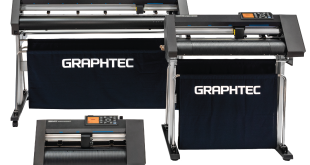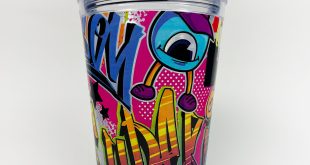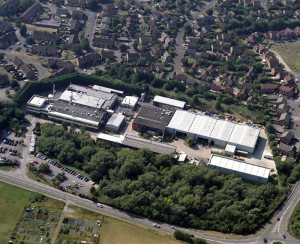
Have you ever wondered where your screen printing emulsions and cleaning products come from? P&P editor MELANIE ATTLESEY was given a behind-the-scenes tour of the MacDermid Autotype factory in Wantage by WILL SHORTER, product manager and technical expert.
Deep in the Oxfordshire countryside in a former jam factory resides the head office and worldwide sales office for MacDermid Autotype and its subsidiary businesses CPS (Chemical Products and Services) and Screen Print Direct.
MacDermid Autotype is an industrial manufacturer of emulsions and fillers and high quality precision coated films and lacquers for the printing, automotive and electronics industries. While CPS, on the other hand, is a specialist manufacturer of safer and environmentally friendly screen printing chemicals. Screen Print Direct is the factory direct webstore for MacDermid Autotype, where customers can purchase their products direct.
The diversity of screen printing
MacDermid Autotype and CPS have been involved in garment screen printing for many years and both have seen significant growth in the market sector in the UK since 2008.
Far from being a method solely used for garment and promotional merchandise decoration screen printing can be used for many diverse products. Some of the more familiar items that can be screen printed include CDs, tiles, plates, bottles, mugs and pens.
Will explains that MacDermid Autotype has expanded its business into industrial applications. Not only does the company manufacture the emulsions and the capillary films, it now produces innovative hard coated substrates to print on to, such as polyesters and polycarbonates.
MacDermid Autotype has moved into the film insert moulding decoration sector for car interior parts, among other things. This process enables decorative printing of complex moulded components.
One of the most interesting growth areas at the moment for screen printers on an industrial scale is solar cells, from printing the circuitry and some of the other components, such as the lenses to focus the lighting. Another growing sector is medical diagnostic equipment. For example diabetes test strips can now be screen printed. The enzymes which detect the blood sugar levels are printed down on to the strip and the circuitry is also printed.
But back to garment printers, Will says that at the moment those in the sector in the UK are experiencing strong demand and growth. He adds: “This is clearly seen by the continued investments in digital and screen printing equipment and the expansion of screen printing at garment printers to meet their needs. Of course there were casualties with mergers and closure of businesses in the aftermath of 2008, but the industry has weathered the storms and is in good health.”
Screen printing will always have a key position in garment decoration especially in the fashion industry says Will. This is because of special effects such as high build and glitters needed to add that extra touch to garments.
Inside the factory
The area of the factory where screen printing emulsions are manufactured is split over two levels – upstairs is where the raw materials are mixed to become the emulsions, while downstairs the pots are filled on a production line.
All emulsions are manufactured to the exacting high quality standards suitable for global industrial markets. As MacDermid Autotype’s emulsions are now predominantly used in industrial applications it makes sense to manufacture the products to the highest standard possible. This is driving the company forwards and in turn passes on the best quality product to the customer.
So how do the emulsions arrive in the pots that you use? The raw materials used in the emulsions arrive at the MacDermid Autotype factory in IBC containers and drums and then, much like baking a cake, the ingredients are decanted in the right measurements into a mixing vessel which holds two tonnes of liquid and operates 24/7. The mixed emulsions need to be filtered and thoroughly tested by the QC department before being approved for filling out into pots on the production line beneath.
MacDermid Autotype manufactures many types of emulsion in this hands-on process. Each emulsion contains very similar raw materials, but they have very different properties due to different grades and proportions. For example some of the emulsions are more durable to particular types of inks, others provide a smoother surface for high definition printing, while others have anti-static properties. To the naked eye the only thing that differentiates them is colour.
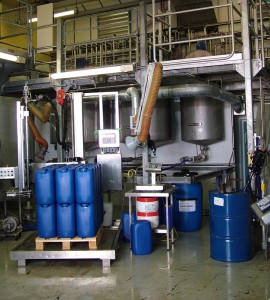
Screen printing chemicals mixed
CPS’ products are mixed in a separate part of the factory in a process which is more automated. Unlike the rest of the plant, the raw materials and solvents which are mixed here arrive via tanker. These are then stored in tanks on site until they are needed.
The products are mixed together using a computerised system that controls pumps and valves to create the product formulation in variable batch sizes from 200 to 2,400 litres.
When it comes to making a particular screen printing chemical, a member of staff instructs the computerised system how much of each solvent is required and one by one these are fed through a series of pipes from the tanks where they are stored into the mixing vessel.
Inside the mixing area are three vessels. Two are used for blending solvents to create cleaning solvents like aqua washes, screen washes and screen openers for use during or after printing. One vessel is used for manufacturing stencil removers, haze removers and degreasers.
Over 150 different CPS products are manufactured in this part of the factory in formats from one to 1,000 litres, which is quite a complex operation.
CPS formulations are created by applying a scientific process called Hansen Solubility Parameters, which allows safer alternatives to traditional cleaning solvents to be selected and used to make products which are designed to be hazard label free, low odour etc.
Once the product is mixed and QC tested, containers are filled, but not labelled at this stage. Instead the containers are just printed with a barcode. The containers are labelled once an order has been made. Due to the number of markets served the labels are produced in over 15 different language variants.
Commitment to the environment
MacDermid Autotype has placed huge emphasis on its commitment to the environment. One of the main reasons for this is because of Letcombe Brook, a globally rare chalk stream which runs through the site. To protect the brook and the wildlife, a water sample is taken once a week from two points in the brook, to ensure that no chemicals have entered the water that shouldn’t be there.
To further protect the brook from being contaminated all drains in the factory are colour coded. Green drains mean that anything which is put down there has the potential to end up in the brook. Red drains are linked to the sewer. As with any factory dealing with chemicals there is always the potential for a spillage. If such an incident happens, a phone call is made to the gate house where the member of staff on duty immediately turns a lever to contain the spillage in a drain underground to prevent anything from entering the brook. A tanker will then arrive on site to empty out the contents of the drain.
Day to day waste water is collected in the effluent balancing tank. A sample is collected and analysed every hour. If a non-conformity is found in the waste water Thames Water is notified before it collects the waste water. With regards to its approach to waste water management, MacDermid Autotype is doing more than is required, mainly because it enforces such strict regulations upon itself to maintain its ISO14001 credentials.
As several houses back on to the factory, MacDermid Autotype has a responsibility towards its neighbours in terms of noise and smells. An oxidising chimney burns off any smells produced by the coating machine manufacturing process. All of the air which comes from the machines is fed into there so the Volatile Organic Compounds (VOCs) are burnt off before the fumes are released into the atmosphere, preventing any nasty smells or airborne emissions from reaching the noses of neighbours.
A key part of the CPS side of business is being environmentally friendly and CPS is careful to follow its ethos by minimising waste and emissions. Trying to balance output and efficiency, while reducing environmental impact is a difficult balancing act. CPS has been engaged with this for the past 30 years and understands that printers need products that work as well as or better than traditional screen chemicals, but at the same time offer real benefits to the user, the working environment and to airborne and waterborne emissions.
Will adds: “Nowadays, solutions are available that allow printers to meet the strict environmental demands of their global clients while remaining highly competitive in terms of production and costs.”
CPS carries through with this ethos in the training and research labs when cleaning screens, the excess cleaning product is collected in a tank and reused until it no longer cleans.
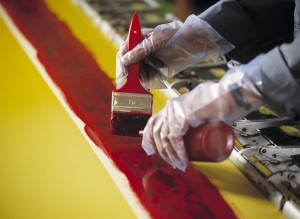
Screen Print Direct
The newest venture for MacDermid Autotype is Screen Print Direct, its webstore launched in September 2014. It provides a platform to purchase screen cleaning products direct to receive the best prices combined with factory direct technical support.
The webstore also provides a community base for screen printers around the world to discuss their ideas, methods, products etc.
Is there a threat from digital printing? Not really says Will.
“Digital print technology is making inroads into the garment printing market sector based on the investment from many of the large garment printing outfits in the UK and globally,” he adds. “It can also be said that as we stand today screen printing is also working in harmony with digital. New hybrid equipment that combines screen for printing the block white / special colours and effects for digital for the four colour image is getting a lot of interest.”
So as you have found out here, screen printing is far from dead. And in the words of Screen Print Direct – screen printers of the world unite!
 Printwear & Promotion The Total Promotional Package
Printwear & Promotion The Total Promotional Package
